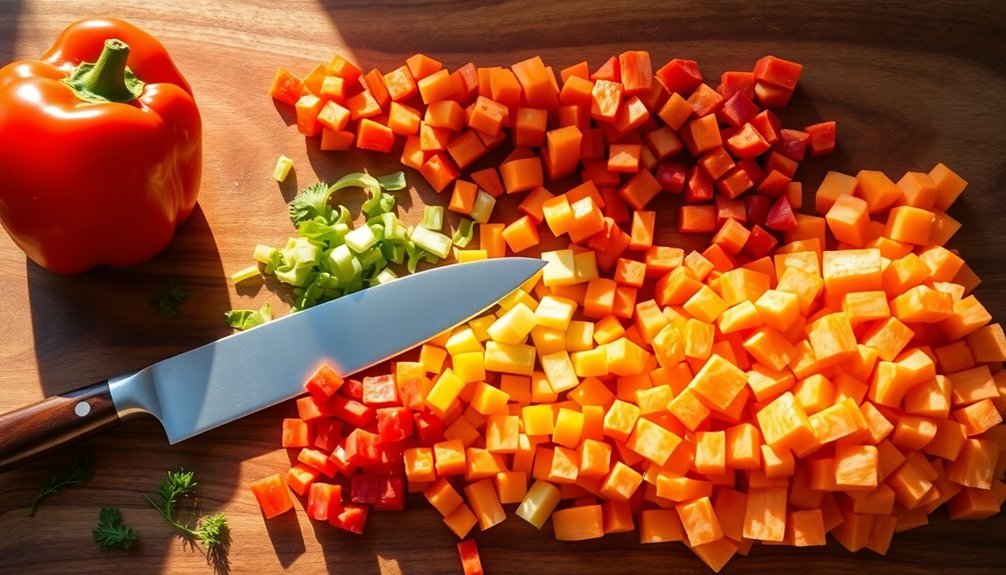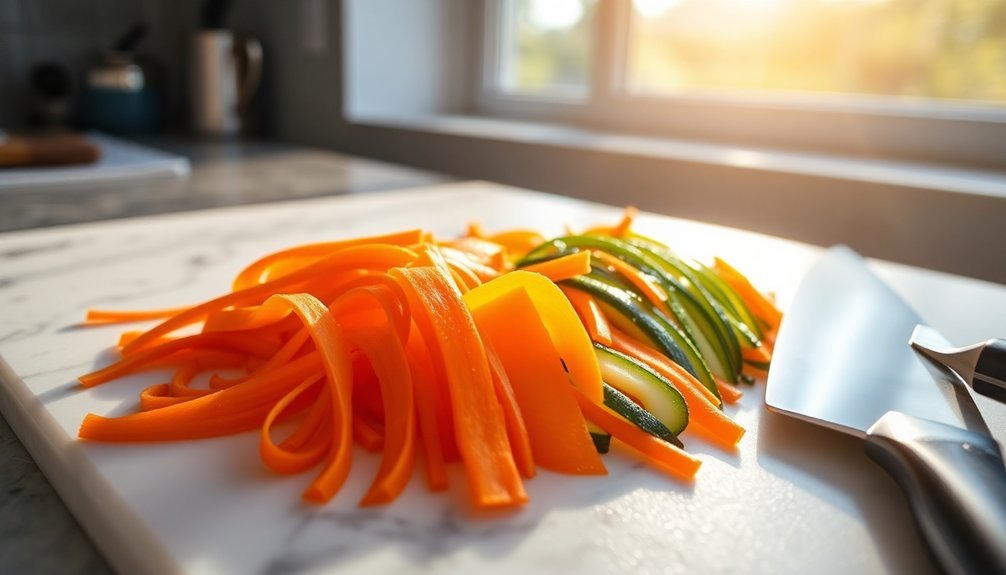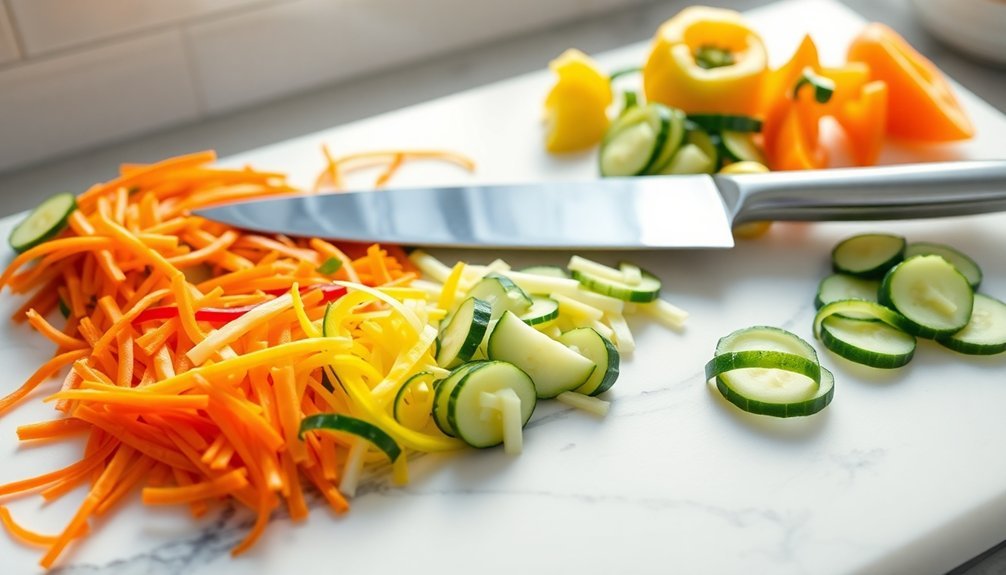Mastering food cutting techniques is vital for perfect sun-cooked meals. You'll need three essential knives: a chef's knife for chopping, a serrated knife for bread, and a paring knife for precision work. Focus on uniform sizing to guarantee even cooking – cut dense vegetables smaller than lighter ones, and aim for consistent shapes like brunoise (tiny cubes) or julienne (matchsticks). Always cut away from your body on a stable surface, and keep your knives sharp for safety and precision. With dark, non-reflective pots and proper cutting techniques, your solar-cooked dishes will transform from basic to exceptional. There's much more to discover about elevating your sun-cooking game.
Essential Kitchen Tools for Cutting

A well-equipped kitchen begins with the right cutting tools.
You'll need three essential knives: a chef's knife for versatile chopping and slicing, a serrated knife for bread and juicy foods, and a paring knife for precise tasks like coring tomatoes and mincing shallots.
For uniform slicing, you'll want a mandoline. The OXO Good Grips hand-held version offers safe, clean cuts and works perfectly over bowls or plates.
If you're into vegetable noodles, a spiralizer will transform your zucchini and carrots into pasta-like strands. Choose between hand-held models for simple jobs or tabletop versions with multiple blade options. The OXO Good Grips Tabletop Spiralizer creates perfect spaghetti and fettuccini cuts with its interchangeable blades.
Don't forget a reliable chopper for quick prep work. The OXO Good Grips Chopper efficiently handles onions, nuts, and herbs without the mess.
Understanding Basic Cutting Techniques
Now that you've got your tools ready, mastering proper cutting techniques will transform your sun-cooked meals. Focus on mastering uniformity to guarantee even cooking when using solar heat. You'll find these basic cuts essential for sun cooking success. Using a serrated knife for bread will give you the cleanest slices with minimal compression.
| Cut Type | Best For | Size Guide |
|---|---|---|
| Brunoise | Garnishes | 1/8-inch cubes |
| Julienne | Stir-fries | Matchstick-sized |
| Dice | Soups & Stews | 1/4 to 1/2-inch |
For precision, grip your knife with your thumb and forefinger on the blade, using a sliding motion rather than chopping straight down. When cutting vegetables, brace the knife against your knuckles to maintain consistent thickness. Practice these techniques with softer vegetables first, then progress to firmer ones as you build confidence.
Uniform Sizing for Solar Cooking

When you're preparing food for solar cooking, the size of your ingredients directly impacts how evenly and efficiently they'll cook.
You'll get the best results by cutting your ingredients into uniform pieces, which allows the sun's heat to penetrate each portion at the same rate.
These consistent sizes help prevent the frustration of having some pieces overcooked while others remain raw, making your solar-cooked meals more reliable and enjoyable.
Since solar cookers can heat up to 400°F or higher, cutting ingredients into smaller, even pieces helps them cook thoroughly in less time.
Why Size Matters
The size of your food pieces plays a critical role in successful solar cooking. When you're preparing ingredients, cutting them uniformly guarantees they'll cook at the same rate and finish simultaneously. You'll want to cut dense vegetables slightly smaller than less dense ones to achieve even cooking.
| Food Type | Ideal Size | Key Benefit |
|---|---|---|
| Dense Veggies | Smaller pieces | Faster cooking time |
| Proteins | Uniform cubes | Even heat distribution |
| Root Vegetables | Thin slices | Consistent results |
Remember that larger food masses cook more slowly in solar cookers, especially under marginal sun conditions. By cutting ingredients into smaller, consistent pieces, you'll maximize your cooker's efficiency and achieve better results. Using dark, non-reflective pots along with properly sized ingredients will help enhance heat absorption and cooking speed.
Achieving Even Solar Heat
Achieving uniform heat distribution in solar cooking requires thoughtful preparation and precise equipment setup.
You'll want to start by positioning your solar oven in direct sunlight between 11:00 am and 3:00 pm, when the sun's rays are strongest. Use dark-colored cookware to maximize heat absorption, and guarantee your oven's interior is black for the same reason.
Adjust your reflective surfaces to concentrate sunlight onto the cooking chamber, and don't forget to reposition the oven periodically to track the sun.
For consistent results, pre-heat your solar oven for up to an hour before cooking. When you're ready to cook, stir liquids and rotate solid foods every 10-15 minutes to maintain even heat distribution.
Add thermal mass, like a brick, to help stabilize temperatures and prevent hot spots in your dishes.
Mastering the Brunoise Cut
You'll need a sharp chef's knife or Japanese blade and a stable cutting board to execute the precise brunoise cut, which creates tiny 3mm cubes essential for sun-cooked soups and stews.
Start by squaring off your ingredients and mastering the julienne cut, as these foundational skills directly impact your brunoise technique.
Following proper knife handling and safety protocols, you can transform your vegetables into uniform brunoise cuts by gathering your julienne strips and dicing them into perfect small cubes.
Essential Tools and Equipment
Mastering brunoise cuts requires a carefully curated set of essential tools and proper technique. You'll need a sharp chef's knife as your primary tool, along with a paring knife for detailed work. A stable cutting board made from softer material will protect your knife's edge while preventing slipping during precise cuts.
For safe and efficient food preparation, organize your workspace with:
- Color-coded cutting boards to prevent cross-contamination
- Non-slip mats beneath your boards for stability
- Sharp, well-maintained knives specific to each task
- Clean, sanitized tools and surfaces
Don't underestimate the importance of your knife's sharpness – it's vital for both safety and precision.
While a chef's knife is your main tool, keeping specialty knives like a petty or nakiri handy will help tackle different ingredients effectively.
Perfect Your Knife Skills
The brunoise cut demands precise knife control to create uniform ⅛-inch cubes that elevate both presentation and cooking efficiency.
You'll start by mastering the julienne cut, then transform those thin strips into tiny, perfect squares. For safety, keep your knife sharp and maintain a claw grip with tucked fingers.
These miniature cubes aren't just for show – they're essential for quick-cooking dishes where even heating matters.
You'll find they're perfect for delicate sautés, refined soups, and elegant garnishes. While larger cuts like macédoine (¼-inch) serve their purpose, the brunoise's small size makes it ideal for professional-grade dishes.
Practice is key. Start with softer vegetables until you're comfortable, then progress to firmer produce.
Remember to rock your knife against your knuckles for consistent control.
Step-by-Step Brunoise Method
Four essential steps transform ordinary vegetables into professional-grade brunoise cuts.
You'll start by preparing your ingredients, ensuring they're firm and suitable for fine dicing. After removing unwanted parts and peeling if needed, cut them into manageable chunks with squared edges for stability.
To achieve perfect brunoise, follow these critical cutting stages:
- Slice ingredients into uniform 2-3mm thick pieces
- Cut these slices into julienne strips of equal width
- Stack and align the strips carefully
- Dice across the strips to create precise 2-3mm cubes
Remember to maintain a sharp knife and stable cutting board throughout the process.
Your brunoise cut vegetables will elevate the presentation of soups, sauces, and salads while ensuring even cooking in your sun-prepared dishes.
Perfecting Julienne Strips

When preparing vegetables for sun-cooked meals, achieving precise julienne cuts can elevate both presentation and cooking consistency.
Begin by peeling your vegetable and removing unwanted parts, then cut it into 2-3 inch segments. You'll need to square off the vegetable by trimming its rounded sides to create a uniform rectangle.
Next, slice the squared vegetable into thin planks, about 1/16 to 1/8 inch thick. Stack these planks carefully, then cut them lengthwise into matchstick-sized strips of the same thickness.
As you cut, use your knuckles to guide the knife for safety and precision. Remember to maintain consistent dimensions throughout the process – this uniformity guarantees your vegetables will cook evenly in the sun.
Don't discard the trimmings; they're perfect for other dishes.
Dicing Methods for Solar Dishes
Since solar cooking requires precise food preparation, mastering proper dicing techniques secures even heat distribution and consistent results. When dicing onions, keep the stem intact while making lengthwise cuts, followed by horizontal slices through the middle. Then, cut crosswise to create uniform dice.
For other vegetables and fruits, you'll want to follow these essential steps:
- Select firm produce and verify it's clean and dry
- Cut ingredients into even slices using a sharp knife
- Stack 2-3 slices at a time for efficient cutting
- Make lengthwise cuts first, then crosswise for perfect dice
Remember that solar cooking retains more moisture than conventional methods, so precise dicing helps control cooking times.
Use dark-colored casseroles for steaming vegetables, and don't forget to adjust your cooker's position as the sun moves.
Time-Saving Food Preparation Tips

To streamline your solar cooking experience, efficient food preparation techniques can cut your kitchen time in half while maintaining quality results.
You'll want to prep ingredients in bulk, chopping vegetables and fruits for multiple meals at once, then storing them in airtight containers.
Make the most of your time by using essential tools like sharp chef's knives and food processors for quick ingredient preparation.
When you're planning sun-cooked meals, cook staples like rice, beans, and chicken in large batches that you can portion and freeze.
Don't forget to label and date everything.
Keep your kitchen organized with easy-to-access tools and a well-stocked pantry.
You'll find that maintaining a list of go-to solar meals and pre-measuring ingredients will considerably reduce your preparation time while ensuring consistent results.
Safe Knife Handling Practices
Mastering safe knife handling practices serves as the foundation for effective solar cooking preparation.
You'll need to maintain sharp blades and proper storage habits to guarantee safety while preparing ingredients for your sun-cooked meals. Always use the appropriate grip technique and keep your fingers protected with the "claw" method when cutting.
For maximum safety during food prep, remember these essential practices:
- Cut away from your body on a stable surface
- Keep knives sharp through regular maintenance
- Store blades in proper sheaths or blocks
- Never try catching a falling knife
When passing a knife to someone else, place it on the cutting board instead of handing it directly.
Keep your workspace clean and dry, and always maintain visual contact with the blade while cutting. These habits will help prevent accidents during your solar cooking preparations.
Frequently Asked Questions
How Does Humidity Affect the Drying Time of Sun-Cooked Vegetables?
High humidity will considerably slow down your vegetables' drying time, as it prevents moisture from evaporating quickly. You'll find that drying takes 1.2-1.3 times longer compared to conditions with low humidity.
Can Different Cutting Techniques Impact the Nutritional Value of Sun-Cooked Foods?
Yes, your cutting technique matters! When you cut against the grain, you'll release more nutrients into cooking liquid, while cutting with the grain helps retain nutrients inside the vegetable cells during sun cooking.
Which Cutting Methods Work Best for Preserving Moisture During Solar Cooking?
You'll retain moisture best by cutting ingredients into medium-sized, uniform pieces. Don't over-chop or cut too finely. Make clean cuts with sharp knives, and wait until just before cooking to prepare your food.
Should Cutting Techniques Change Based on Seasonal Variations in Sunlight Intensity?
You'll want to cut foods thicker in summer when sun's intense, and slice them thinner in winter's weaker light. This adjustment helps guarantee even cooking despite seasonal changes in sunlight intensity.
How Do Altitude and Air Pressure Influence Cutting Thickness for Sun-Cooking?
You don't need to adjust cutting thickness for altitude, but you'll want to focus on consistent cuts to guarantee even cooking, since altitude affects cooking time rather than how thick you slice ingredients.
In Summary
You've now mastered the essential cutting techniques needed for successful solar cooking. By maintaining uniform sizes and following proper knife handling practices, you'll guarantee even cooking in your sun-powered dishes. Whether you're julienning vegetables or creating perfect dice cuts, these skills will transform your solar meals. Keep practicing these methods, and you'll consistently prepare professional-looking ingredients for your eco-friendly outdoor cooking adventures.





Leave a Reply